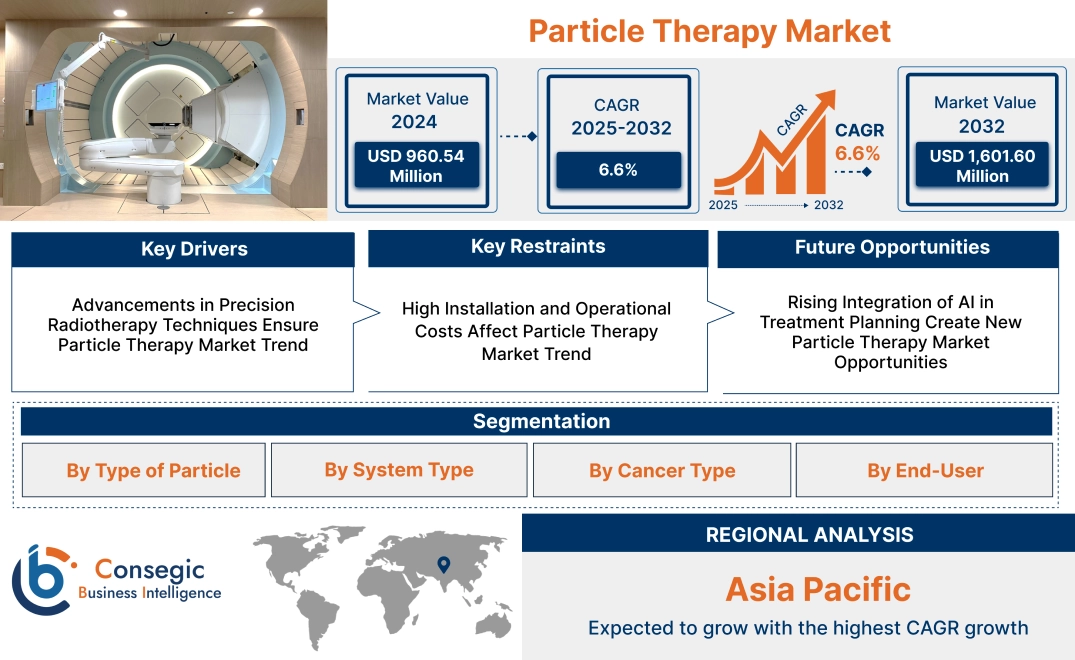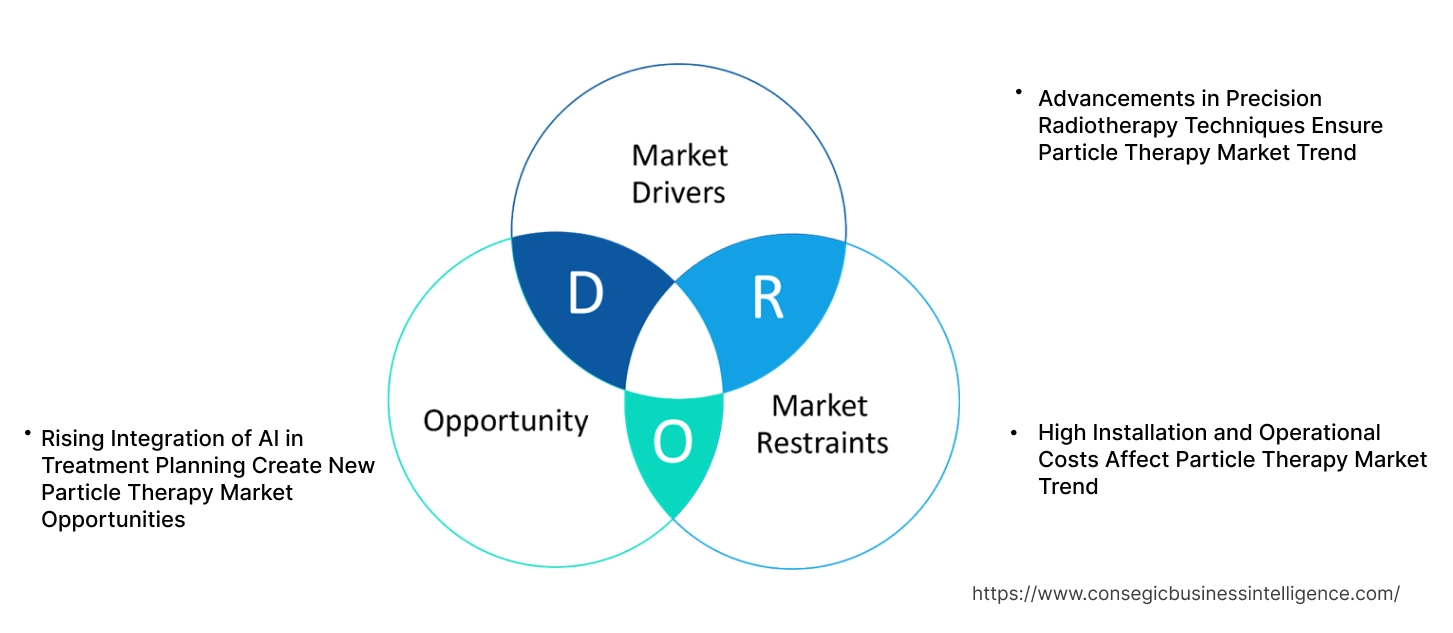Particle Therapy Market Size:
Particle Therapy Market size is estimated to reach over USD 1,601.60 Million by 2032 from a value of USD 960.54 Million in 2024 and is projected to grow by USD 1,006.82 Million in 2025, growing at a CAGR of 6.6 % from 2025 to 2032.
Particle Therapy Market Scope & Overview:
Particle therapy is an advanced form of radiation therapy that uses high-energy proton or carbon ion beams to treat cancer and other conditions. It offers precision targeting, minimizing damage to surrounding healthy tissues and reducing treatment-related side effects.The technology incorporates features such as high-dose delivery accuracy, enhanced imaging systems, and real-time monitoring for optimal treatment planning. Facilities employ state-of-the-art particle accelerators and advanced control systems for efficient therapy.
Benefits include improved tumor control, reduced long-term complications, and better outcomes for complex or inoperable tumors. It is particularly effective for treating pediatric cancers, deep-seated tumors, and radiation-resistant conditions. Applications include oncology centers, research institutions, and specialized treatment clinics. End-use industries consist of hospitals, proton therapy centers, and academic institutions focused on advancing cancer treatment techniques.
How is AI Impacting the Particle Therapy Market?
AI is enhancing the particle therapy market by improving treatment planning, automating processes, and increasing operational efficiency, leading to more personalized and precise patient care. Additionally, the key impacts include faster and more accurate dose delivery, automated contouring and quality assurance, predictive maintenance of equipment, and the potential for adaptive treatments. AI algorithms optimize dose distribution and automate the complex process of delineating organs at risk from medical images, which significantly reduces preparation time.
Key Drivers:
Advancements in Precision Radiotherapy Techniques Ensure Particle Therapy Market Trend
The increasing adoption of precision radiotherapy techniques in oncology has significantly enhanced treatment outcomes for cancer patients. Particle therapy, which includes proton and heavy ion therapy, allows for accurate tumor targeting while minimizing damage to surrounding healthy tissues. This capability is particularly beneficial for treating tumors located near critical organs, where conventional radiation therapies might pose higher risks. For example, proton therapy has proven effective in treating pediatric cancers, reducing the long-term side effects associated with radiation exposure.
Therefore, the advancement of precision radiotherapy techniques boosts the particle therapy market by addressing the growing demand for targeted cancer treatment solutions.
Key Restraints:
High Installation and Operational Costs Affect Particle Therapy Market Trend
The implementation of particle therapy facilities requires significant capital investment due to the complex technology and infrastructure involved. Proton therapy centers, for instance, demand specialized equipment such as cyclotrons or synchrotrons, which are costly to manufacture and maintain. Additionally, operational costs, including skilled personnel and energy consumption, further increase the financial burden on healthcare providers. Smaller hospitals and clinics often struggle to justify these expenses, especially in regions with limited healthcare budgets.
These substantial costs limit the adoption of particle therapy, particularly in developing countries, thus restraining the particle therapy market growth potential.
Future Opportunities :
Rising Integration of AI in Treatment Planning Create New Particle Therapy Market Opportunities
The integration of artificial intelligence (AI) in treatment planning is expected to revolutionize the particle therapy market. AI algorithms enable precise dose calculation, tumor segmentation, and real-time adjustments during therapy, improving treatment accuracy and efficiency. For instance, AI-driven solutions are being developed to automate image analysis and predict patient outcomes, ensuring personalized and optimized care.
As healthcare facilities continue to adopt AI-based technologies, the particle therapy market is anticipated to benefit from improved treatment workflows, making it more accessible and effective for patients worldwide.
Particle Therapy Market Segmental Analysis :
By Type of Particle:
Based on the type of particle, the market is segmented into proton therapy and carbon ion therapy.
Proton therapy accounted for the largest revenue in particle therapy market share in 2024.
- Proton therapy uses positively charged protons to target cancer cells while minimizing damage to surrounding healthy tissues.
- It is widely used for treating various cancers, including prostate, lung, and pediatric tumors, due to its precision and lower side effects.
- Increasing availability of proton therapy systems globally and its effectiveness in managing complex cancer cases are contributing to its significant revenue share.
- Advances in technology have improved the accessibility and efficiency of proton therapy systems in oncology.
- Its ability to treat tumors located near vital organs and its potential to reduce radiation exposure make it a preferred treatment option.
- Ongoing clinical trials and research are expanding the range of cancer types that can benefit from proton therapy.
- Therefore, according to particle therapy market analysis, proton therapy dominates the particle therapy market, supported by its precision and global availability.
The carbon ion therapy sector is anticipated to register the fastest CAGR during the forecast period.
- Carbon ion therapy delivers higher energy particles, making it effective against radio-resistant tumors.
- Its ability to provide a higher relative biological effectiveness (RBE) compared to proton therapy enhances treatment outcomes for difficult cancers.
- Growing adoption in research and clinical applications and advancements in system designs are driving its rapid demand.
- Carbon ions have been shown to cause more effective DNA damage in cancer cells, increasing their effectiveness for aggressive cancers.
- The high cost of carbon ion therapy systems is gradually being offset by its growing clinical applications and evidence of superior outcomes for hard-to-treat cancers.
- Thus, according to particle therapy market analysis, carbon ion therapy is emerging as a transformative technology, showing promising trend potential.
By System Type:
Based on the system type, the market is segmented into single-room systems and multi-room systems.
Multi-room systems accounted for the largest revenue in particle therapy market share in 2024.
- Multi-room systems enable the treatment of multiple patients simultaneously, improving operational efficiency.
- They are primarily adopted in large hospitals and cancer treatment centers due to their capacity to handle high patient volumes.
- High upfront costs are offset by long-term benefits, including reduced per-patient treatment costs.
- Their scalability and ability to integrate advanced particle therapy technologies contribute to their widespread use.
- Multi-room systems support the development of specialized treatment plans for different cancer types, enhancing their treatment capabilities.
- Hospitals and large medical centers benefit from the use of multi-room systems for both proton and carbon ion therapies.
- Therefore, according to market analysis, multi-room systems lead the market, supported by their efficiency and scalability for high patient volumes.
Single-room systems are anticipated to register the fastest CAGR during the forecast period.
- Single-room systems offer a cost-effective alternative for smaller clinics and research institutions.
- These systems are compact and require less infrastructure, making them ideal for expanding access to particle therapy in underserved regions.
- Increased adoption by private healthcare providers and advancements in compact system designs drive particle therapy market demand.
- Their lower operational costs and ability to cater to specific patient needs make single-room systems an attractive investment.
- The versatility of single-room systems enables better resource management in smaller or regional facilities.
- Thus, according to market analysis, single-room systems show rapid particle therapy market demand due to their affordability and compact design, catering to smaller facilities.
By Cancer Type:
Based on cancer type, the market is segmented into prostate cancer, lung cancer, brain and spinal cord tumors, head and neck cancer, breast cancer, and other cancers.
Prostate cancer accounted for the largest revenue share in 2024.
- Proton and carbon ion therapies are particularly effective for localized prostate cancer due to their precision.
- Reduced side effects, such as lower risks of urinary and bowel complications, make particle therapy a preferred option.
- Increasing incidence rates of prostate cancer and growing awareness of advanced treatment modalities drive this segment's dominance.
- Proton therapy’s ability to deliver highly focused radiation to the prostate with minimal impact on surrounding healthy tissues makes it highly effective.
- Research on the long-term outcomes of proton therapy in prostate cancer patients is boosting its reputation as a reliable treatment.
- Therefore, according to market analysis, prostate cancer dominates the market due to the targeted and effective treatment provided by particle therapy.
Brain and spinal cord tumors are anticipated to register the fastest CAGR during the forecast period.
- These tumors require high precision to avoid damaging surrounding critical brain structures.
- Particle therapy provides targeted treatment with minimal neurological side effects, enhancing patient outcomes.
- Rising prevalence of brain cancers and advancements in image-guided particle therapy support its rapid growth.
- The ability of proton and carbon ion therapies to target deeply embedded tumors with less damage to healthy tissue is especially beneficial for brain and spinal cord cancers.
- Ongoing research into particle therapy’s role in treating gliomas and other aggressive brain tumors is contributing to particle therapy market expansion.
- Thus, according to market analysis, brain and spinal cord tumors exhibit fast growth due to the precision and safety of particle therapy for critical regions.
By End-User:
Based on end-user, the market is segmented into hospitals, cancer treatment centers, and academic and research institutes.
Cancer treatment centers accounted for the largest revenue share of 51.50% in 2024.
- Specialized cancer treatment centers are equipped with state-of-the-art particle therapy systems to treat complex cancer cases.
- These centers prioritize advanced technologies to improve patient outcomes and maintain their competitive edge.
- Partnerships and investments from governments and private players enhance the availability of particle therapy systems in these facilities.
- Cancer treatment centers are increasingly focusing on offering personalized treatment options, integrating particle therapy into their services.
- The high specialization and expertise in these centers make them a preferred choice for patients requiring advanced treatments like proton and carbon ion therapies.
- Therefore, according to market analysis, cancer treatment centers dominate the market due to their focus on advanced technologies for comprehensive cancer care.
Academic and research institutes are anticipated to register the fastest CAGR during the forecast period.
- Academic and research institutes are increasingly adopting particle therapy systems for oncology research and clinical trials.
- Advancements in research funding and collaborations with healthcare providers accelerate the adoption of cutting-edge particle therapy systems.
- These institutes contribute to the development of next-generation particle therapy technologies.
- The role of academic institutions in conducting clinical trials and developing new particle therapy protocols is expected to drive innovation in the market.
- They are pivotal in educating future oncology professionals on the application and benefits of particle therapy, promoting wider adoption.
- Thus, according to market analysis, academic and research institutes are growing rapidly as they drive innovation and adoption of advanced therapies.
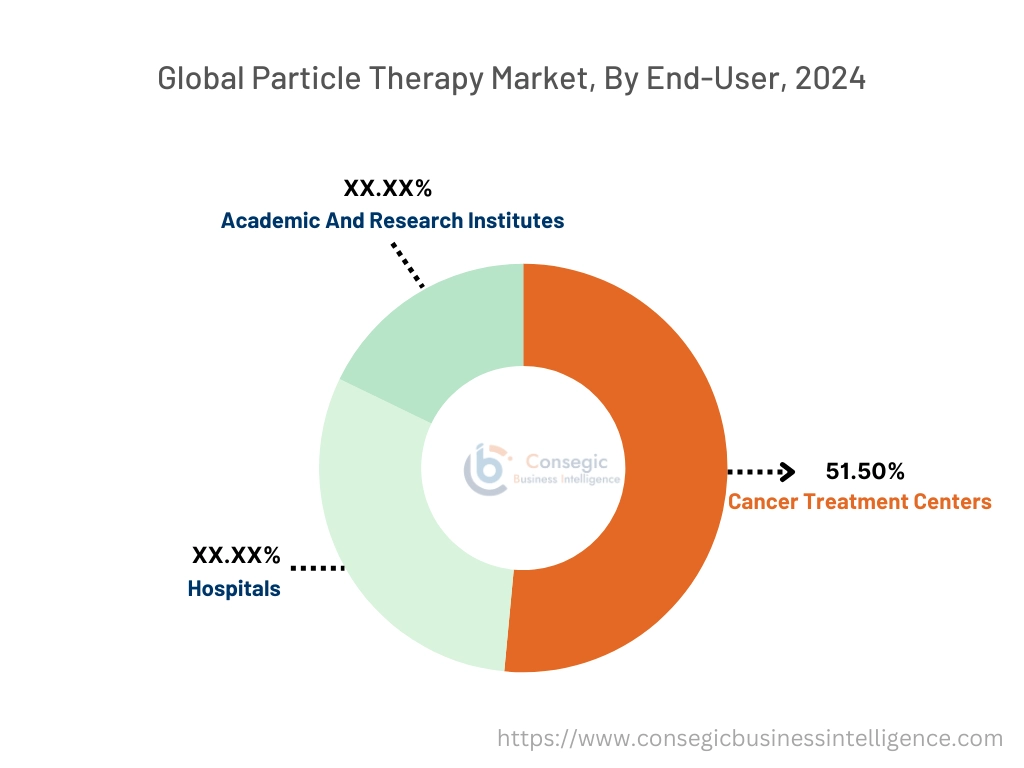
Regional Analysis:
The regional segment includes North America, Europe, Asia Pacific, Middle East and Africa, and Latin America.
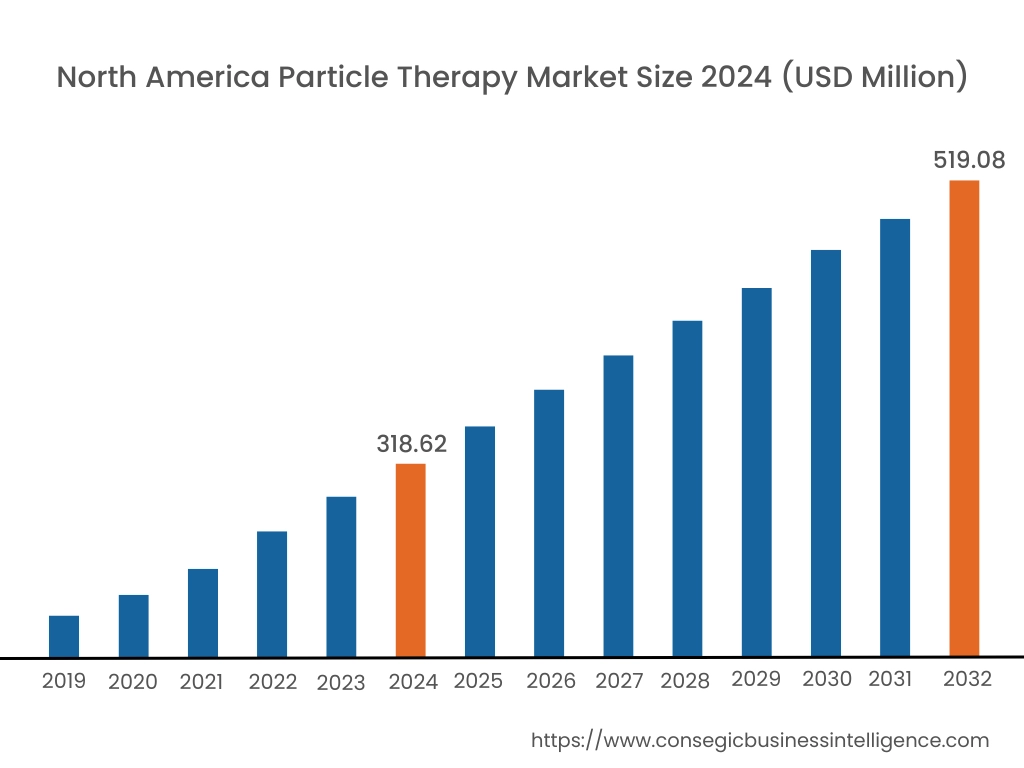
In 2024, North America was valued at USD 318.62 Million and is expected to reach USD 519.08 Million in 2032. In North America, the U.S. accounted for the highest share of 72.10% during the base year of 2024. North America dominates the particle therapy market, driven by the presence of leading healthcare institutions, advanced medical technologies, and significant investments in cancer research. The United States, with its well-established healthcare infrastructure, holds the largest share in the market. Increasing adoption of proton therapy for treating various cancers and rising awareness about the benefits of particle therapy contribute to particle therapy market growth. Supportive government policies and reimbursement schemes further enhance the market landscape in this region.
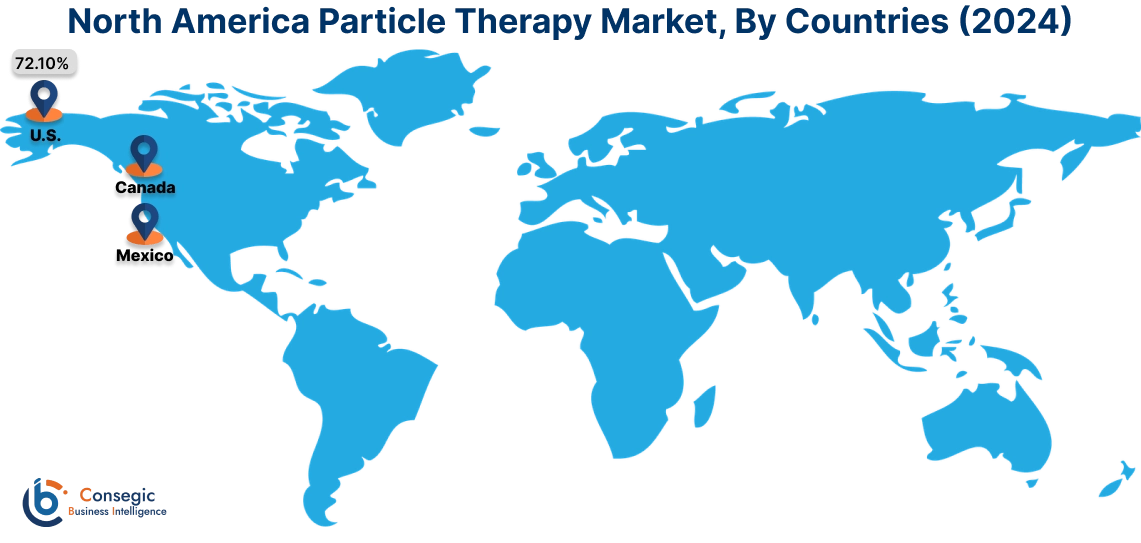
In Asia Pacific, the market is experiencing the fastest growth with a CAGR of 7.0% over the forecast period. Asia-Pacific exhibits rapid growth in the particle therapy market, particularly in countries like Japan, China, and South Korea. Japan remains a key player, with the country’s long-standing use of proton therapy and extensive research into particle beam technologies. China and South Korea are expanding their particle therapy capabilities, with significant investments in healthcare infrastructure and increasing access to advanced cancer treatment options. While the region faces challenges related to high initial setup costs, favorable government initiatives are likely to support the market in the coming years.
Europe has a well-established market for particle therapy, with significant adoption in countries like Germany, France, and Italy. The region benefits from advanced healthcare systems, substantial government funding for cancer treatment, and research initiatives on particle therapy technologies. Germany leads Europe in the number of proton therapy centers and is a major contributor to the regional market. However, the high cost of establishing particle therapy centers presents a barrier in some countries, limiting the market's potential in certain regions of Europe.
The Middle East and Africa region is still in the early stages of adopting particle therapy. In the Middle East, countries like the UAE and Saudi Arabia are making strides in cancer treatment by investing in advanced healthcare infrastructure. However, Africa faces significant challenges in terms of accessibility to particle therapy due to limited healthcare facilities and high treatment costs. Government initiatives aimed at improving healthcare and international collaborations for setting up cancer treatment centers in the region are expected to gradually enhance the market in the Middle East. In Africa, market growth remains slow due to economic constraints and limited access to advanced technologies.
Latin America is witnessing gradual development in the particle therapy market, primarily in Brazil and Mexico. These countries are expanding their healthcare facilities and investing in advanced cancer treatment technologies, including particle therapy. However, the high cost of establishing particle therapy centers and limited access to trained professionals pose challenges to widespread adoption. Despite these barriers, growing healthcare investments and collaborations with international organizations are helping to improve access to proton therapy and other advanced treatment options, paving the way for steady market progress in the region.
Top Key Players and Market Share Insights:
The Global Particle Therapy Market is highly competitive with major players providing FWA to the national and international markets. Key players are adopting several strategies in research and development (R&D), product innovation, and end-user launches to hold a strong position in the Global Particle Therapy Market. Key players in the Particle Therapy industry include-
- Varian Medical Systems (United States)
- Siemens Healthineers (Germany)
- Ion Beam Applications S.A. (IBA) (Belgium)
- Accuray Incorporated (United States)
- Elekta AB (Sweden)
- Hitachi Ltd. (Japan)
- Mevion Medical Systems (United States)
- ProNova Solutions (United States)
- Sumitomo Heavy Industries, Ltd. (Japan)
- RaySearch Laboratories AB (Sweden)
Particle Therapy Market Report Insights :
| Report Attributes | Report Details |
| Study Timeline | 2019-2032 |
| Market Size in 2032 | USD 1,601.60 Million |
| CAGR (2025-2032) | 6.6% |
| By Type of Particle |
|
| By System Type |
|
| By Cancer Type |
|
| By End-User |
|
| By Region |
|
| Key Players |
|
| North America | U.S. Canada Mexico |
| Europe | U.K. Germany France Spain Italy Russia Benelux Rest of Europe |
| APAC | China South Korea Japan India Australia ASEAN Rest of Asia-Pacific |
| Middle East and Africa | GCC Turkey South Africa Rest of MEA |
| LATAM | Brazil Argentina Chile Rest of LATAM |
| Report Coverage |
|
Key Questions Answered in the Report
How big is the Particle Therapy Market? +
In 2024, the Particle Therapy Market was USD 960.54 million.
What will be the potential market valuation for the Particle Therapy Market by 2032? +
In 2032, the market size of Particle Therapy Market is expected to reach USD 1,601.60 million.
What are the segments covered in the Particle Therapy Market report? +
The type of particle, sustem type, cancer type, and end-user are the segments covered in this report.
Who are the major players in the Particle Therapy Market? +
Varian Medical Systems (United States), Siemens Healthineers (Germany), Hitachi Ltd. (Japan), Mevion Medical Systems (United States), ProNova Solutions (United States), Sumitomo Heavy Industries, Ltd. (Japan), RaySearch Laboratories AB (Sweden), Ion Beam Applications S.A. (IBA) (Belgium), Accuray Incorporated (United States), Elekta AB (Sweden) are the major players in the Particle Therapy market.
